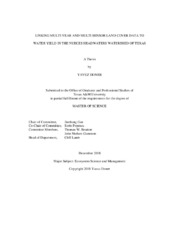| dc.contributor.advisor | Gan, Jianbang | |
| dc.contributor.advisor | Popescu, Sorin | |
| dc.creator | Doner, Yavuz | |
| dc.date.accessioned | 2019-01-23T21:39:47Z | |
| dc.date.available | 2020-12-01T07:32:25Z | |
| dc.date.created | 2018-12 | |
| dc.date.issued | 2018-11-19 | |
| dc.date.submitted | December 2018 | |
| dc.identifier.uri | https://hdl.handle.net/1969.1/174589 | |
| dc.description.abstract | The stress on water resources is more critical in drylands due to ecological and climatological changes. Because upscaling the findings of paired-catchment studies to larger watersheds is difficult, hydrological models like the Soil and Water Assessment Tool (SWAT) were oftentimes used to investigate the impact of land use and land cover changes (LULC) on water yield. Such modeling studies first require the accurate estimates of LULC change using remote sensing images, which has been hindered by the presence of shadows in these images. Also, the data used in many previous modeling studies didn’t have the extent of variations in LULC and other variables including climatic conditions comparable to the simulation scenarios. The objectives of this study are to classify LULC types in the shadow areas of aerial images; to evaluate the complement between LULC data and ancillary data; to estimate LULC change; and to assess the impact of the LULC change on the water yield of the Nueces River Headwaters watershed using multi-year and multi-sensor LULC data and the SWAT model.
More than 99% of the shadow area was identified with a 92.68% average accuracy. This outcome indicates that LULC types of shadow area on higher-resolution images can be classified successfully with a straightforward method incorporating the multi-sensor LULC classification schemes. The high accuracy of multi-year and multi-sensor LULC maps revealed the benefits of ancillary data use in remote sensing image classification. LULC change detection analysis was conducted using higher-resolution
maps for precise quantification. There was at least an 8% reduction in juniper cover from 2008 to 2014 in the watershed. To account for variations in LULC, 2008, 2012 and 2016 maps were used to set up multiple SWAT models. Although satisfactory model performance statistics obtained from calibration, model performance was degraded for the validation period. This indicated that the model couldn’t sufficiently assess the variation in LULC and weather for a relatively brief period in the specific karst watershed. This study may be the first study conducted in a large karst watershed in the Edwards Plateau which accounted for the watershed-wide LULC changes for the entire modeling period. | en |
| dc.format.mimetype | application/pdf | |
| dc.language.iso | en | |
| dc.subject | SWAT | en |
| dc.subject | NAIP | en |
| dc.subject | Landsat | en |
| dc.subject | LULC | en |
| dc.subject | karst watershed | en |
| dc.subject | Ecohydrology | en |
| dc.subject | HRU | en |
| dc.title | Linking Multi-Year and Multi-Sensor Land Cover Data to Water Yield in the Nueces Headwaters Watershed of Texas | en |
| dc.type | Thesis | en |
| thesis.degree.department | Ecosystem Science and Management | en |
| thesis.degree.discipline | Ecosystem Science and Management | en |
| thesis.degree.grantor | Texas A & M University | en |
| thesis.degree.name | Master of Science | en |
| thesis.degree.level | Masters | en |
| dc.contributor.committeeMember | Boutton, Thomas w. | |
| dc.contributor.committeeMember | Nielsen-Gammon, John | |
| dc.type.material | text | en |
| dc.date.updated | 2019-01-23T21:39:47Z | |
| local.embargo.terms | 2020-12-01 | |
| local.etdauthor.orcid | 0000-0002-4365-1247 | |


